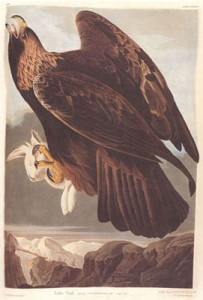The record-breaking price for a double elephant folio edition of John James Audubon’s Birds of America in London on December 9, 2010, prompts the question: Does the Society own a copy. The short answer is no — not the double elephant folio edition — but the story is more interesting than that. Indeed, AAS came THAT close (note small capitals, not large, and certainly not bold). If AAS had been a subscriber, the sale would have been made by Audubon himself.
In December 1840, Audubon was on a tour to sell his work in the United States. The AAS Librarian at the time, Samuel Foster Haven, had already received a letter from the president of the Society’s Council, Thomas L. Winthrop, encouraging him to consider a purchase:
Mr. Audubon will call at the Society’s office and request you show him the Library. He will have with him a few copies of his celebrated Ornithology. I wish our Society could conveniently possess itself of his valuable works, having been disappointed in the ability of a considerable portion of his foreign subscribers to fulfill their engagements to pay him for his original work, he has been induced to publish it on a reduced scale, to consist of eighty-six numbers, at one dollar each.
Winthrop’s bibliographic reference was to a new, more affordable edition of Birds of America. Audubon had introduced an octavo edition (like the double elephant folio, it was also offered as fascicles) and was selling subscriptions to both. Audubon had also issued the text accompanying the illustrations in five volumes between 1831 and 1839 as Ornithological Biography: An Account of the Habits of the Birds of the United States of America, 5 vols. (Edinburgh, 1831-39), co-authored with the Scottish naturalist and ornithologist William MacGillivray.
While in Worcester, Audubon was hosted by the local bookseller, Clarendon Harris, who duly brought him to the library as part of the tour of Worcester people and places. Without talking turkey, Haven suggested that Audubon visit Elihu Burritt, the “learned blacksmith,” then residing in Worcester and studying in AAS collections, and return later. So Audubon and Harris continued on their way, visiting other prospects, and stopping for “2 glasses of good wine” with Attorney Isaac Davis. Audubon then returned to Antiquarian Hall to meet with Haven hoping to sell a subscription. But the library was already locked up! The librarian had departed for the weekend, and Audubon was scheduled to be on his way to Hartford, Connecticut, before the library would reopen.
AAS notwithstanding, Audubon made twelve sales in Worcester, all of the octavo edition. Not surprisingly, several were purchased by members of the American Antiquarian Society. While Haven left no statement on the matter, he might well have considered that one of these sets might one day reach the Society. If so, his surmise would have been correct, even if he could not have predicted which subscriber would be the donor. The complete copy now in the AAS collections has this provenance:
American Antiquarian Society copy the gift of Frances M. Lincoln, 1928. Inscribed: Frances M. Lincoln, Jan. 1866; ‘I give and bequeath to my granddaughter Frances Merrick Lincoln my copy of Audubon’s Birds of America, which is a subscription copy of that work and presented to me by my late husband; the same to be preserved by her as a token of remembrance.’ From the will of Mrs. Mary B. Merrick; M.B. Merrick.
This set had been purchased by F. T. Merrick. Stephen Salisbury bequeathed not his octavo edition, but his copy of the Ornithological Biography, and several other parts of the octavo edition are now in the collections as well.
As the guide to the Society’s collections indicates: “We have not yet obtained a set of that great book and we despair of ever again having the opportunity of doing so.” This leaves us to wonder, what if Audubon had not stayed at Worcester’s Temperance Hotel, where there was no wine in the cellar, and thereby passed up a tipple with Isaac Davis?; and would Haven have committed one hundred dollars for a subscription?
For further reading:
Gregory H. Nobles, “Ornithology and Enterprise: Making and Marketing John James Audubon’s The Birds of America” Proceedings of the American Antiquarian Society (Oct. 2003): 267-302 (available for purchase on the AAS website as offprint number 1009).
John James Audubon’s double elephant folio edition of The Birds of America (4 vols., 1827-38), a massive work of natural history that offers the reader an innovative interplay between image and text, still stands as one of the most remarkable artistic and scientific achievements in the history of the book. For Audubon, though, producing this “Great Work” proved to be as much about entrepreneurship as ornithology. The changes in the popular perception of Audubon’s birds from his time to our own is the background for looking at the connection between the cultural and commercial significance of this big book about birds, which represents both an investigation of nature and an investment in art. The various ways people have valued Audubon’s work leads to the question of whether The Birds of America is — or should be — a book at all.

One thought on “Audubon at the American Antiquarian Society”